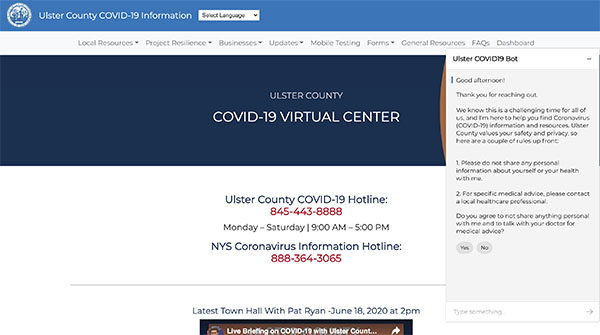IBM and Coronavirus stories
With Watson Assistant, AI Is a Crucial Provider of Public Information
By Diane Cardwell
As coronavirus infections tore through New York State earlier this year, Ulster County, a collection of small towns and farmland nestled in the Hudson River Valley, set up a hotline to answer its citizens’ questions about coping with the pandemic.
Soon, as local officials around the country and around the world were also finding , the volume of public inquiries quickly overwhelmed the Ulster County government. Callers were stuck with long waits—if they could get through at all.
So Pat Ryan, a tech entrepreneur who as County Executive is intent on using technology to improve government operations, turned to a company with a long, proud history in the region: IBM. Before long, Ryan said, the company was providing the county government with Watson Assistant. It’s an AI-enabled virtual agent, or what some people refer to as a chatbot, trained to answer a wide variety of questions related to COVID-19.
Thus far, the assistant has handled more than 5,200 online conversations, answering basic public health questions about the spread of the virus and avoiding infection, as well as connecting people with human services and guiding businesses as they begin to reopen. That, in turn, has freed up the county’s 15 call center agents to handle more complex requests.
Ulster County is but one of more than 100 organizations around the globe that are using the Watson Assistant tool to support COVID-19 communications. The virtual assistant is handling about 175,000 to 200,000 queries each week. Since the start of the pandemic, IBM has been offering the virtual agent free for 90 days to governments, universities and healthcare operators.
The use of Watson Assistant has been so successful that the county is planning to expand its use to more parts of the government and to add a voice component. (The virtual agent can be used both as an online chatbot via voice phone calls.)
“It reaffirmed my general idea that this would work, and it opened the eyes of a lot of people on my team who may not have understood what value this really provides to our county,” Mr. Ryan said. “So now you’re going to have residents in a 200,000-plus-person county that can rapidly get answers to all these questions and ultimately get connected to services that might be life-saving for them.”

Ulster County's Watson Assistant has handled more than 5,200 online conversations about COVID-19,
freeing the county's call center agents to focus on the most complex queries.
An Increasingly Vital Tool
Organizations using Watson Assistant are getting a frontline view of the importance of advanced technologies like AI—not only for surviving the current crisis, but also thriving as they being to emerge from it, IBM executives say.
“Many of these organizations had a 10- to 100-times increase in requests from what they’ve ever had before—you can’t throw manpower at that,” said Toby Cappello, IBM’s vice president for Data and AI Expert Labs and Learning. “A lot of organizations are apprehensive,” about adopting new technologies, Cappello said. “But if they don’t change, they’re going to get overwhelmed. This is one of those things that pays massive dividends.”
As the nature of the COVID-19 crisis evolves to include challenges like unemployment, food insecurity and reopening workplaces, Watson Assistant has been evolving along with it, said Zachariah Eslami, delivery leader in North America for Data and AI Expert Labs and Learning. Watson support teams have added information in new subject areas that the agent can access.
The information, Eslami said, is moving beyond responses to queries like “What are disinfectant practices?” to, “Is my insurance providing me assistance for this?” or “Where do I go to file for unemployment benefits?”
In Austin, Texas, for instance, a Watson virtual agent is available on the city’s website to answer medical questions as well as those related to issues like school closures and unemployment. Idaho and Minnesota have applied it to voting information and outdoor activities, respectively.

Ulster County Executive Pat Ryan
Unexpected Insights
One way in which users have found benefits, Capello said, is in anticipating citizen needs that officials might not have expected. In Maricopa County, Arizona, for instance, the top question has been how, with government buildings closed, residents could get a marriage license. In response, officials created an online solution.
There were lessons for IBM as well, particularly in seeing how fast the Watson teams could move, often getting systems up and running in just a few days. The COVID response, Eslami said, “showed the power of Watson to train and scale quickly.”
In Ulster County, Watson analytics that showed high numbers of questions about economic, social and human service assistance are helping officials decide which agencies to include as they expand the original COVID-based hotline into a virtual center designed to meet a broad range of needs.
“We anticipate that the needs are actually going to get much greater in the coming months, not lessen,” Ryan said, especially in areas like economic support, unemployment, food, housing, mental health and addiction.
“We are going to use both the chatbot and the voice agent as key components of this Recovery Service Center that we’re building,” he said, “so that we can serve the maximum number of people as best as possible.”